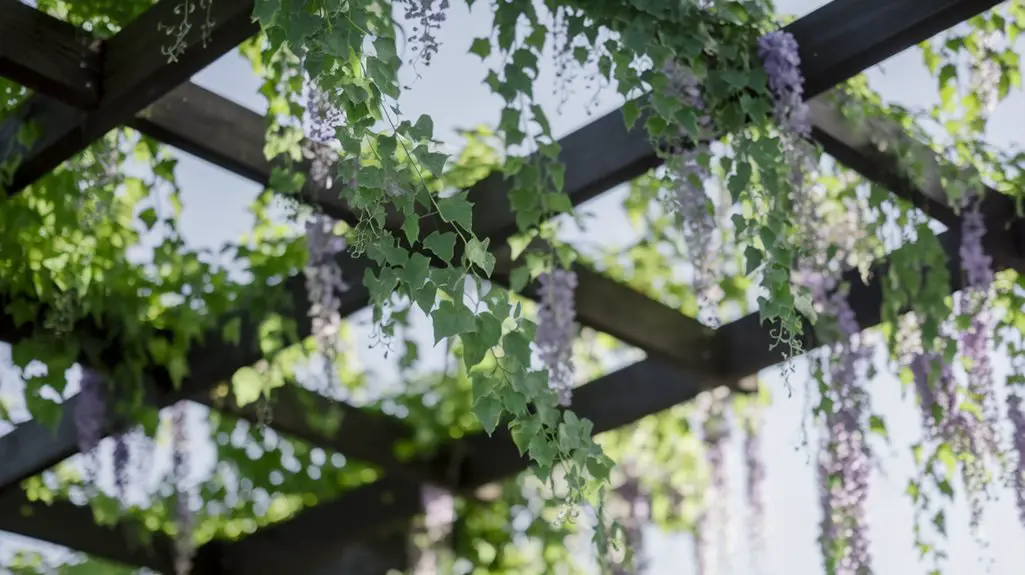Just as architects carefully select materials for structural integrity and beauty, your choice of climbing plants transforms a pergola from mere framework to living sanctuary. The relationship between vine and structure creates a symbiotic design where each enhances the other. Your selection should balance growth rate with maintenance requirements, flower production with foliage density, and seasonal interest with climate suitability. Let's explore ten exceptional vines that excel in vertical garden applications and discover which might suit your outdoor space.
Wisteria: The Classic Cascading Beauty
Although revered for its pendulous flower clusters, Wisteria (Fabaceae family) requires careful selection and management before being introduced to your pergola structure.
These vigorous climbers develop substantial woody stems that can reach 10 meters in length and exert significant tension on supporting frameworks.
You'll find two primary species suitable for pergolas: Chinese wisteria (W. sinensis) with its counterclockwise twining habit and Japanese wisteria (W. floribunda), which twines clockwise and produces longer racemes.
Both require full sun exposure and well-drained, slightly acidic soil.
Prune twice annually—summer for controlling vegetative growth and winter for developing flowering spurs.
Without proper maintenance, you'll wait 5-7 years for blooms.
Consider planting grafted specimens to accelerate flowering, as seed-grown plants demonstrate extended juvenile periods.
Climbing Roses: Elegance With Fragrance
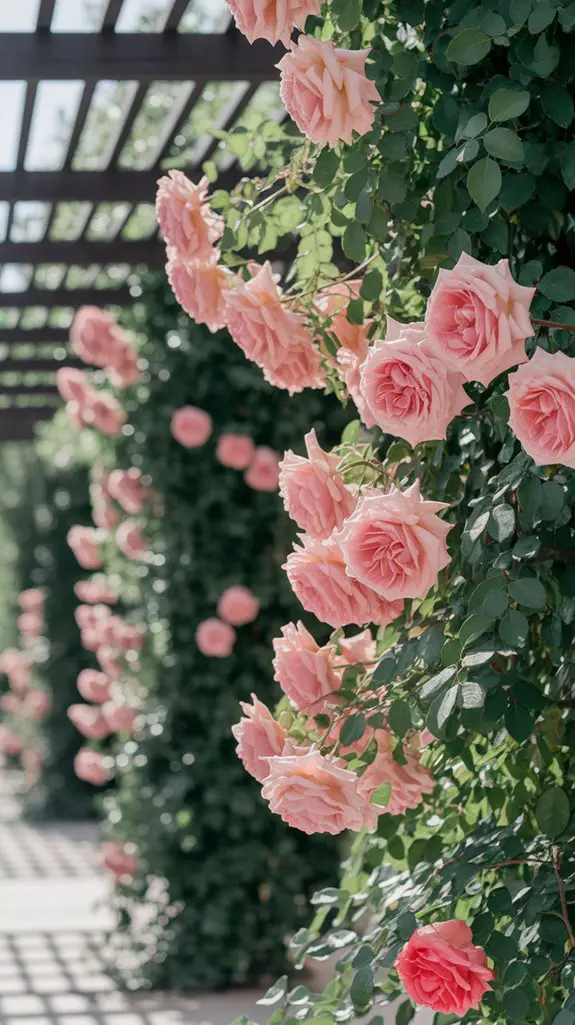
Unlike Wisteria's cascading blooms, climbing roses (Rosa spp.) offer both vertical beauty and intoxicating scent for your pergola structure. These woody perennials require sturdy support as they don't climb independently but must be trained and tied to your pergola framework. To further enhance your garden's ecosystem, consider planting pollinator-friendly herbs alongside your climbing roses to attract beneficial insects.
| Variety | Fragrance | Height |
|---|---|---|
| 'New Dawn' | Mild, fruity | 12-20' |
| 'Zéphirine Drouhin' | Strong, damask | 10-15' |
| 'Cecile Brunner' | Sweet, tea-like | 15-25' |
| 'Don Juan' | Rich, damask | 10-12' |
For ideal growth, plant your climbing roses in well-draining soil with 6+ hours of direct sunlight daily. Prune in late winter, removing dead wood and laterals that have flowered. You'll enjoy abundant blooms from late spring through fall with proper maintenance.
Jasmine: Intoxicating Evening Scents
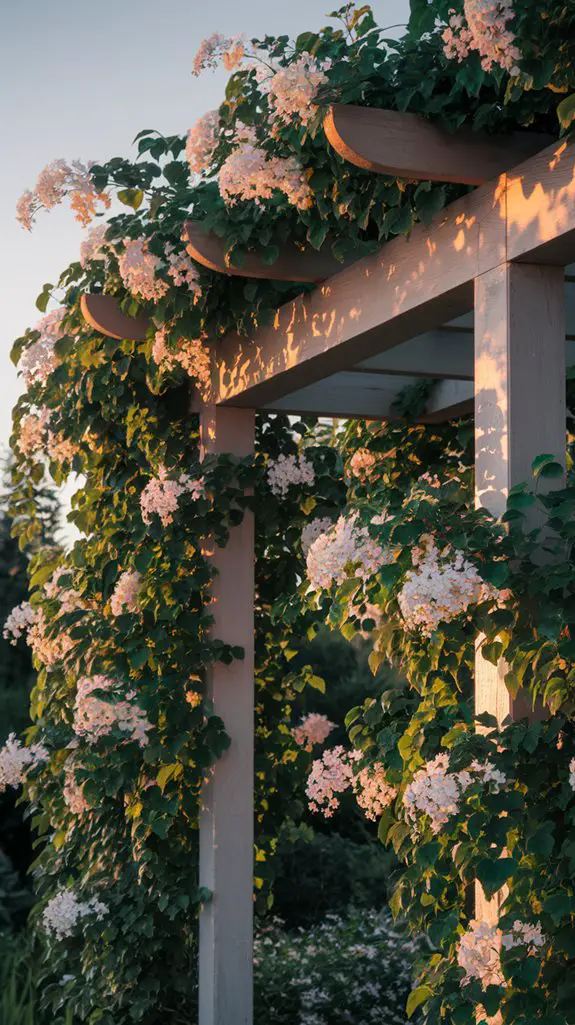
Several jasmine species (Jasminum spp.) provide pergola owners with exceptionally fragrant climbing options that release their sweet perfume primarily during evening hours.
The star jasmine (Trachelospermum jasminoides), despite not being a true jasmine, delivers clusters of white, star-shaped blooms from spring through summer in USDA zones 8-10.
For cooler regions, consider the versatile common jasmine (J. officinale), which thrives in zones 7-10 and produces intensely scented white flowers.
Pink jasmine (J. polyanthum) offers earlier blooms with reddish-pink buds that open to white flowers in late winter.
You'll need sturdy support systems as these vines can reach 20-30 feet.
Plant jasmine in well-draining soil with morning sun and afternoon shade.
Regular pruning after flowering helps maintain shape and control growth.
Clematis: Year-Round Color Variety
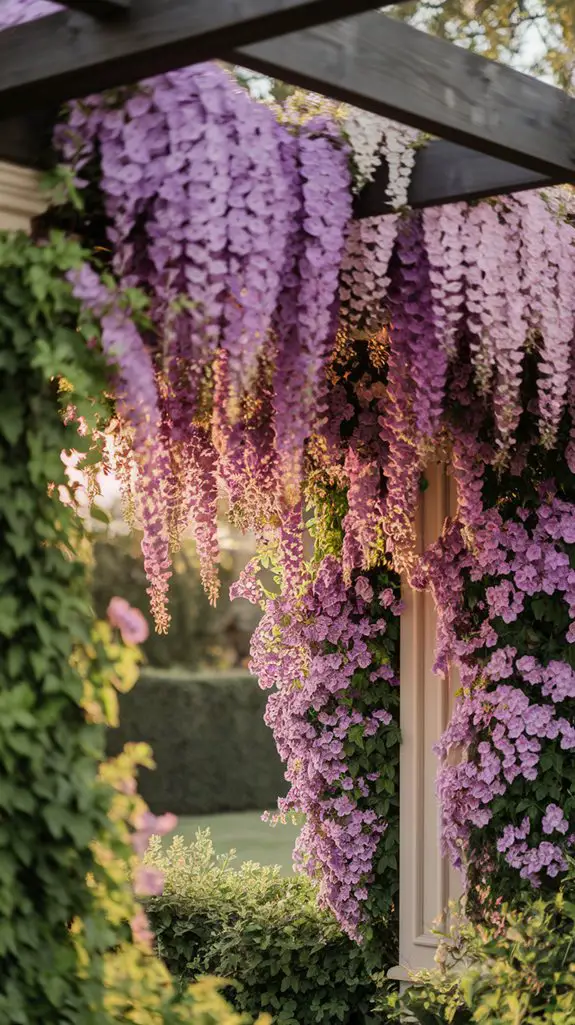
While jasmine enchants with nocturnal fragrance, clematis (Clematis spp.) captivates with its remarkable diversity of colors and blooming periods.
Taxonomically divided into three pruning groups, clematis offers year-round visual interest for your pergola structure.
Group 1 cultivars, like C. montana and C. alpina, flower on old wood in early spring.
Group 2 varieties, including the popular 'Nelly Moser' and 'Duchess of Edinburgh', produce both spring blooms on old growth and summer flowers on new stems.
Group 3 types, such as C. viticella and the late-flowering C. texensis, bloom exclusively on current year's growth.
You'll find specimens ranging from pristine whites to deep purples, some with bell-shaped blooms, others with open, star-like flowers measuring up to 10 inches in diameter.
Additionally, incorporating clematis into your garden design can enhance the vertical gardening benefits of small outdoor spaces by maximizing vertical space and adding lush greenery.
Honeysuckle: Attracting Pollinators With Sweet Nectar
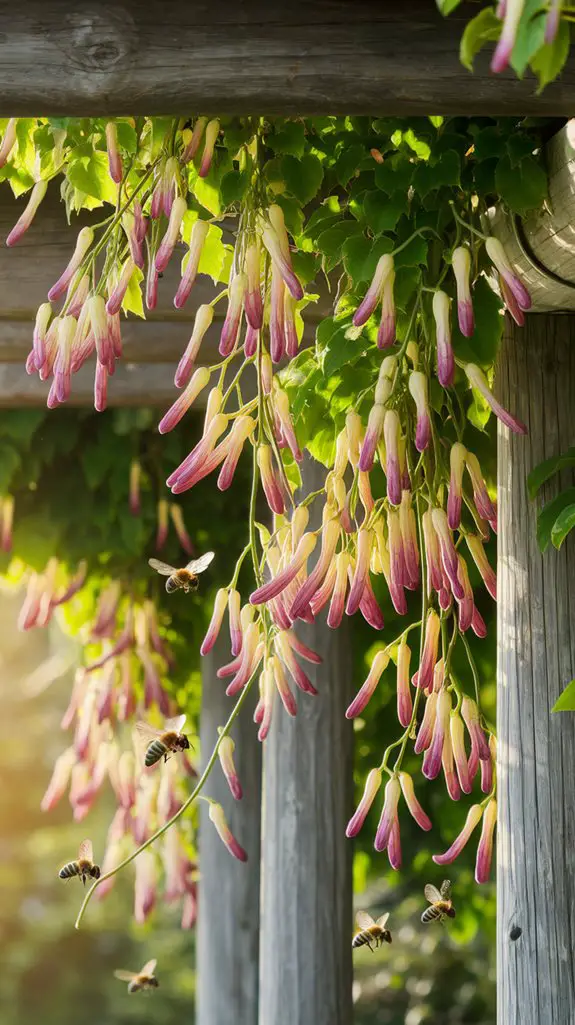
Renowned for its enchanting tubular blooms dripping with sweet nectar, Lonicera (honeysuckle) serves as an exceptional pergola vine that transforms your structure into a dynamic ecosystem hub. The genus comprises approximately 180 species, with Lonicera japonica and L. sempervirens among the most suitable cultivars for vertical cultivation.
You'll observe hummingbirds, bees, and butterflies visiting these fragrant blossoms from late spring through summer. The plant's twining habit allows stems to reach 15-30 feet, requiring minimal training compared to other climbers. Most varieties thrive in zones 4-9 with adequate sunlight.
For ideal growth, plant in well-draining soil amended with organic matter, maintaining consistent moisture during establishment. Additionally, incorporating native plant species in your garden can enhance biodiversity and support local wildlife.
Prune after flowering to control spread and prevent invasive tendencies, particularly with non-native species.
Passion Flower: Exotic Blooms For Drama
If honeysuckle brings pollinators to your pergola, Passiflora (passion flower) introduces theatrical elements through its architecturally complex blooms. The genus features intricate flowers with radial filaments forming a corona above five petals and sepals, creating an almost alien appearance.
Passiflora incarnata and P. caerulea thrive in USDA zones 6-9, climbing via tendrils to heights of 20-30 feet. You'll appreciate their rapid growth habit, which can cover a pergola within two seasons. The vines produce edible fruits following pollination in warmer climates.
For ideal flowering, plant passion flowers in well-draining soil with six hours of sunlight daily. They'll tolerate partial shade but produce fewer blooms. Additionally, incorporating container vegetable gardening can enhance your overall garden aesthetic while maximizing space efficiency.
Prune in early spring to control growth and stimulate flowering. Most species demonstrate drought tolerance once established but benefit from consistent moisture during blooming periods.
Grape Vines: Dual Purpose Beauty With Edible Rewards
For those seeking both aesthetic appeal and culinary benefits, Vitis species transform pergolas into productive garden features while providing dappled shade. These deciduous climbers establish quickly, with robust trunks developing architectural character as they mature. Additionally, raised garden beds can enhance the overall gardening experience by improving soil drainage and accessibility for grape cultivation.
| Variety | Climate Zone | Yield Characteristics |
|---|---|---|
| V. vinifera 'Cabernet' | 7-10 | Dark berries, late harvest |
| V. labrusca 'Concord' | 4-8 | Blue-purple fruit, sweet |
| V. rotundifolia 'Muscadine' | 6-10 | Bronze-purple, disease resistant |
| V. amurensis 'Amur' | 2-8 | Small dark berries, cold hardy |
| V. riparia 'Riverbank' | 3-9 | Small tart fruit, early ripening |
You'll need sturdy support structures—grape vines can exceed 100 pounds when mature and fruit-laden. Prune annually during dormancy following the spur or cane system to maintain productivity. The large, lobed leaves provide excellent summer shade before developing striking autumn coloration.
Morning Glory: Fast-Growing Annual Color
While grape vines offer permanence and edible rewards, morning glories (Ipomoea spp.) present a different approach to pergola coverage. These fast-growing annuals climb rapidly via twining stems, reaching 10-15 feet in a single season, making them ideal for gardeners seeking quick vertical interest. Morning glories are also well-suited for backyard vegetable gardening, as they can be grown alongside edible plants to enhance aesthetics.
Morning glory varieties provide exceptional color diversity:
- *Ipomoea purpurea* – The common morning glory features heart-shaped foliage and trumpet-shaped blooms in purple, blue, pink, and white.
- Ipomoea tricolor'Heavenly Blue' – Produces iconic sky-blue flowers with white throats that open at dawn.
- Ipomoea nil'Scarlett O'Hara' – Offers rich crimson blooms contrasting against deep green foliage.
You'll find morning glories particularly advantageous for seasonal coverage, as they self-sow readily but won't become woody or permanent fixtures requiring maintenance during dormant months.
Trumpet Vine: Hummingbird Haven With Bold Blooms
Trumpet vine (*Campsis radicans*), known also as cow-itch vine, establishes itself as a vigorous, deciduous climber prized for its spectacular tubular blooms that attract hummingbirds in abundance to your pergola.
This North American native produces clusters of orange-red, trumpet-shaped flowers from mid-summer through early fall.
You'll need sturdy support for this aggressive grower, as it can reach 30-40 feet with woody stems that attach via aerial rootlets.
Its compound leaves with 7-11 serrated leaflets provide dense coverage.
USDA zones 4-9 support trumpet vine cultivation, though it's considered invasive in some regions.
Prune severely in late winter to control growth and maximize flowering.
Plant in well-drained soil with full sun exposure for ideal blooming.
Patience is required—plants typically take 3-5 years to mature enough for flowering. Additionally, trumpet vine is known to be best for attracting backyard wildlife, making it a valuable addition to any garden.
Virginia Creeper: Spectacular Fall Color Transformation
Virginia creeper (*Parthenocissus quinquefolia*) stands as a remarkable deciduous vine that transforms your pergola with its dramatic seasonal color shifts, particularly in autumn when its five-pointed compound leaves change from summer green to brilliant scarlet, crimson, and purple hues.
This native North American vine adheres to structures via specialized adhesive discs, eliminating the need for additional support systems. You'll appreciate its robust growth habit, reaching heights of 30-50 feet when mature.
For ideal Virginia creeper cultivation:
- Plant in well-draining soil with pH 5.0-7.5
- Position in full sun to partial shade for best fall coloration
- Prune in late winter to control spread and maintain desired form
While visually stunning, note that its berries are toxic to humans but provide valuable winter sustenance for birds.
Conclusion
Your vine selection transforms a pergola into a veritable botanical showcase. Each species contributes distinct morphological characteristics—from Wisteria's pendulous racemes to Vitis's productive tendrils. By evaluating your microclimate, soil composition, and structural support capacity, you'll hit the nail on the head with your selection. Consider each vine's growth habit, bloom period, and maintenance requirements to create a thriving vertical garden that elevates your outdoor living space throughout multiple seasons.

